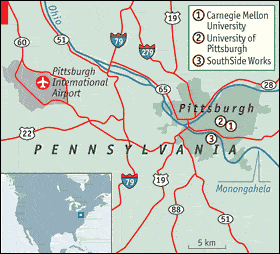
Pittsburgh
How now brown town?
Sep 14th 2006 | PITTSBURGH
From The Economist print edition
A former steel city is now proclaiming its cleaner land and clever minds
A FEW years ago, the Pittsburgh region was so desperate to hang on to its brightest young people that its boosters thought about running television ads featuring “Border Guard Bob”, a patrolman who would have stopped youngsters on their way out of town and urged them to stay. Wisely, the boosters scrapped that idea. And increasingly it seems as though the worries were misplaced anyway. Many of the graduates from Pittsburgh's 34 universities—led by Carnegie Mellon and the University of Pittsburgh—do stick around, and some of them are finding work in cutting-edge scientific fields. A couple of decades after the collapse of the local steel industry prompted many Pittsburghers to flee, the city has a rosier future.
Pittsburgh will not experience an explosion of population and investment, like the booming cities of America's south-west. But it is part of a pleasant and affordable region with an improving mix of industries and enviable demographics—which is as much as many parts of the country can hope for. And besides shaping young minds, Pittsburgh is also doing its best to reshape old land, by cleaning up former mining and industrial sites for uses that suit the modern economy.
One place where these two trends converge is in the SouthSide Works development, a 34-acre (14-hectare) collection of shops, offices and living space being built on the site of an old LTV steel plant on the Monongahela river. The idea, which is popular in many other American cities, is to try to create an area close to the centre of town where young professionals can live and play, as well as work. That might improve Pittsburgh's appeal to creative or knowledge-intensive workers—and those who employ them.
The SouthSide Works aside, however, plenty of clever young people already seem to be staying. Although the region's overall education levels are not that impressive, says Chris Briem, an economist at the University of Pittsburgh, those figures are partly skewed by its high ratio of elderly residents. Among Pittsburghers 25-34 years old, by contrast, 41.9% have graduated from university, placing the city among America's top ten. More than 17% of those young people have also earned an additional graduate or professional degree: the fourth-highest share in the country, behind only Washington, DC (think lawyers), Boston and San Francisco.
Much of Pittsburgh's drive to clean up brownfield sites is more mundane than SouthSide Works, or the engineering and biotech labs in the city's universities. But it is nonetheless useful in updating and rounding out the local economy. The city has plenty of land near the airport, for example, that will soon be accessible on a new highway spur connected to the interstate system. That could be appealing to companies looking for new places to put distribution centres—a crucial bit of America's logistics-driven economy. Some of this land is undercut by old mines, so the government is blasting the mines open, filling areas back in and then flattening them out.
These efforts have a clear logic to them. Pittsburgh is within one day's drive, or a short flight, of the whole eastern seaboard, which accounts for more than half of America's retail sales. But it has lower costs than the big coastal cities. Its potential appeal as a logistics hub thus gives it a fighting chance of attracting the sort of distribution investments that have helped such cities as Louisville, Kentucky and Memphis, Tennessee, though on a smaller scale. A few thousand such jobs would help many locals with moderate levels of education. The city is already showing off a sprawling distribution facility for Dick's Sporting Goods, a big retailing chain.
As Pittsburgh upgrades its local economy, it will increasingly have demography on its side. Because so many prime-age workers moved away in the early 1980s—often taking children with them—it now has lots of old folk. At the last census, in 2000, 15.6% of Pennsylvania's population was over 64 years old—second only to Florida—and the Pittsburgh region is older than the rest of the state. But now the Grim Reaper will even things out. Over the next quarter-century, however, the Census Bureau expects Pennsylvania's over-64 population to grow by only 50%, the smallest increase of the 50 states. The national elderly population will grow more than twice as quickly, while that of currently vibrant states in America's south-west will explode. When today's most glamorous regions begin to face that brutal arithmetic, many of today's young Pittsburghers may be glad they stayed put.
No comments:
Post a Comment